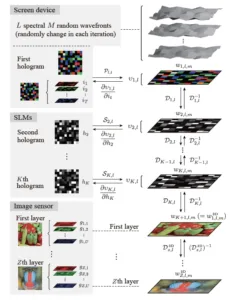Researchers at The University of Tokyo have advanced a novel method of producing three-dimensional, full-color holographic images using computer-generated holography (CGH) with incoherent light sources like smartphone screens. This method deviates significantly from traditional holography that depends on lasers, which not only are expensive and complex but also pose potential risks to the human eye due to their coherent light.

The team, led by Otoya Shigematsu and Ryoichi Horisaki, used a mobile phone screen, specifically an iPhone, and a single spatial light modulator (SLM) to construct a two-layer holographic display. This innovative approach capitalizes on the incoherent light emitted by the mobile screen, which simplifies the optical system by eliminating the need for laser sources. The primary objective of their research is to reduce both the complexity and cost of holographic displays while minimizing potential eye hazards.
Their experimental setup involves a color intensity image displayed on the smartphone that acts as the first hologram layer, while subsequent holograms utilize amplitude or phase modulation provided by the SLM. This setup demonstrates the feasibility of using ordinary electronic devices as part of a holographic display, potentially making this advanced technology more accessible for everyday applications such as augmented and virtual reality.
The researchers developed a new algorithm to manage the propagation of this incoherent light through the system, which includes the modeling and simulation of light through various spectral channels. The method demonstrated a promising fidelity in reproducing high-quality 3D images by solving an inverse problem to optimize the displayed holograms.
Reference
Shigematsu, O., Naruse, M., & Horisaki, R. (2024). Computer-generated holography with ordinary display. Optics Letters, 49(8), 1876–1879. https://doi.org/10.1364/OL.516005

